Everything You Need to Know About Large Sliding Doors
Table of Contents
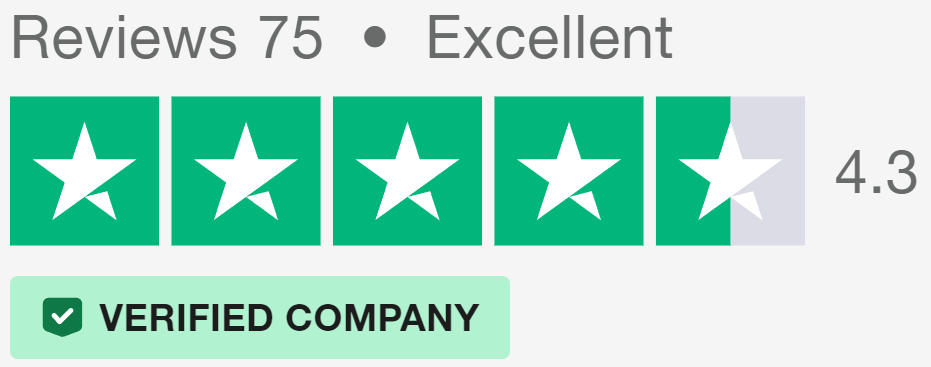
Introduction to Large Sliding Doors
Large sliding doors (also known as slide doors, or when they open onto a patio, patio doors) break the mould of standard door dimensions, offering expansive views and smooth movement between rooms (or between indoors and outdoors).
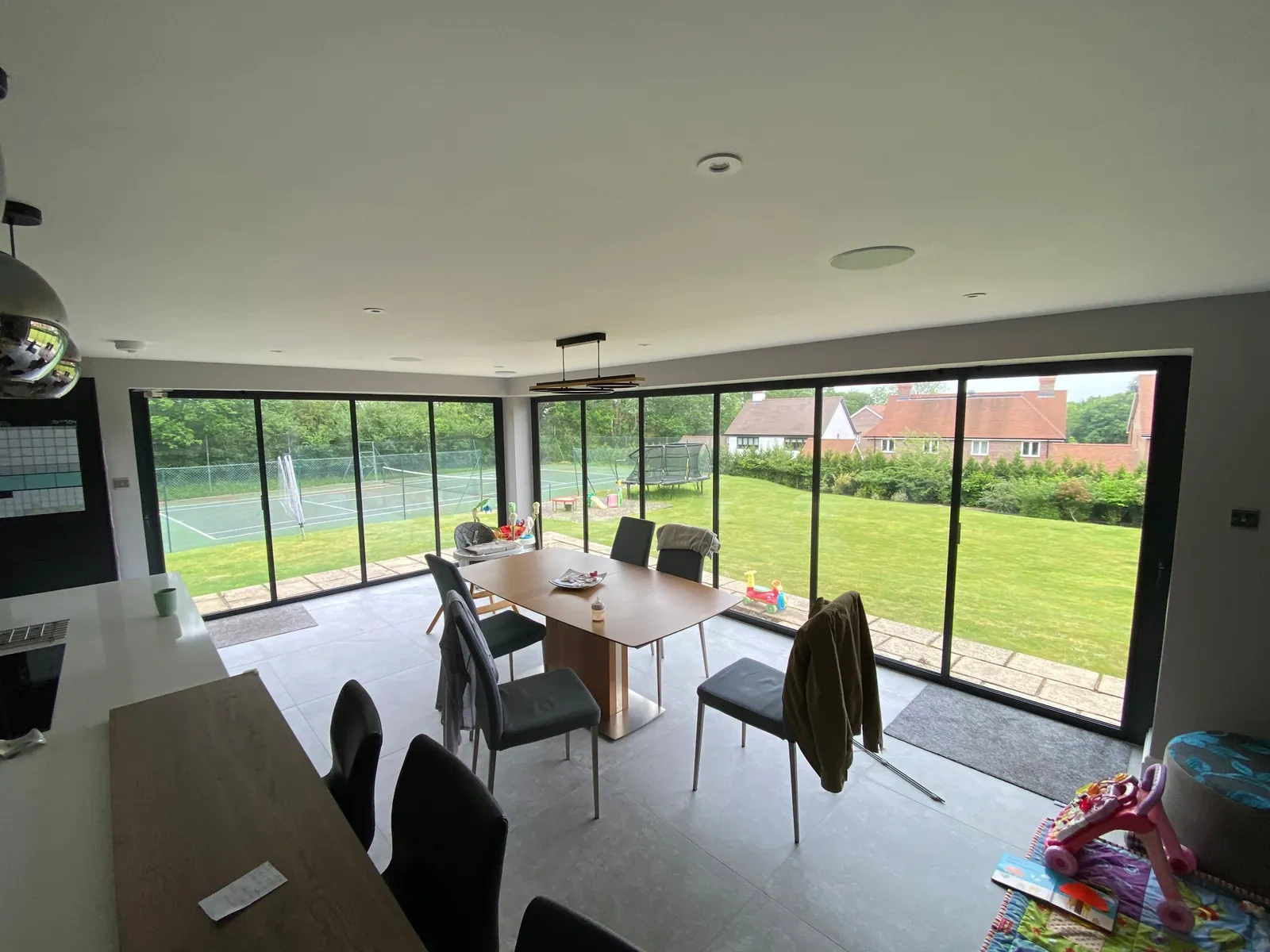
Size Matters
Typical large sliding doors stretch beyond 2.1 metres in height and 1.8 metres in width per panel. Some systems can span entire walls, reaching up to 3 metres high and 10 or more metres wide when multiple panels are combined. The sheer scale of these doors allows for unobstructed sightlines and ample natural light.
As dimensions increase, so does the weight of large sliding doors. A single panel can tip the scales at over 150 kg, necessitating robust hardware and careful installation. This heft impacts how the doors operate and the strength required to move them.
Engineers tackle the weight issue through innovative track systems and rollers. High-quality large sliding patio doors often feature precision-engineered bearings that distribute weight evenly, ensuring smooth gliding despite the door’s mass. Some manufacturers incorporate lift-and-slide mechanisms, which slightly raise the door when the handle is turned, reducing friction and making movement effortless.
The added weight of large sliding doors also influences frame choices. Doors with aluminium outer frames, thanks to the metal’s strength-to-weight ratio, have become increasingly popular. They provide the necessary support without the bulkiness of traditional timber frames, maintaining a sleek profile that complements the expansive glass.
Large internal sliding doors face similar weight challenges, though they often benefit from more controlled environments. Without exposure to external elements, these doors can sometimes use lighter materials or thinner glass, striking a balance between size and manageability.
Types of Large Sliding Doors
Large Sliding Patio Doors
Traditional large sliding patio doors remain a popular option for many British homes. These doors typically feature two or more panels, with at least one mobile panel that glides along a track. A standard configuration might include a fixed panel and a sliding panel, but larger openings often incorporate multiple sliding panels.
The appeal of these doors lies in their simplicity and reliability. They’re well-suited for spaces where a full opening isn’t always necessary, allowing homeowners to control ventilation and access easily. Large sliding doors of this type often span openings of 3 to 4 metres, though custom installations can be much wider.
Modern patio sliders have come a long way from their predecessors. Today’s versions boast improved insulation, smoother operation, and slimmer frames that increase the glass area. Some manufacturers offer triple-track systems, allowing two-thirds of the opening to be clear when fully open.
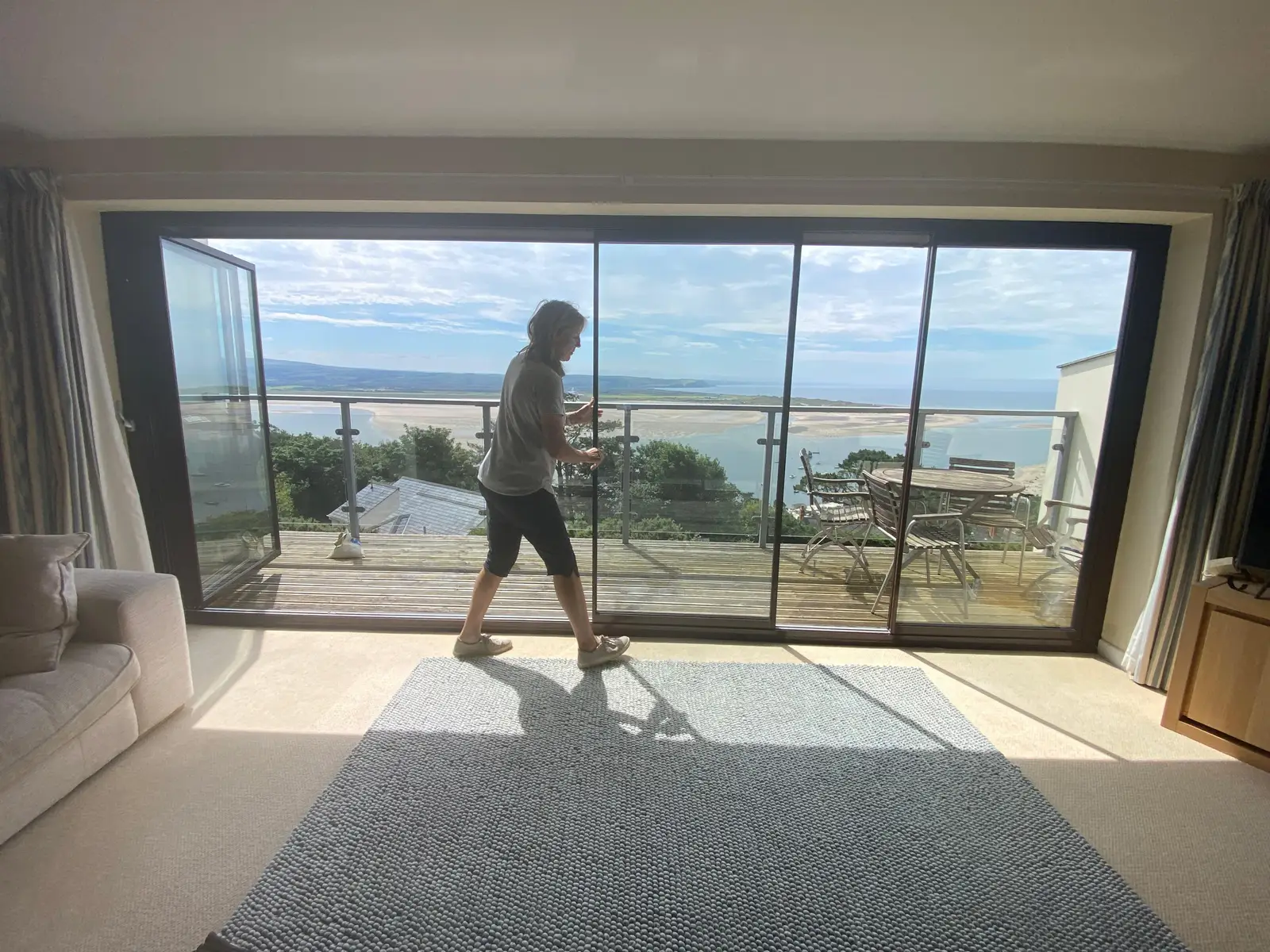
Slide and Stack Doors
For those seeking to create truly expansive openings, slide and stack doors (also known as slide and fold doors) offer an impressive solution. These large sliding doors consist of multiple panels that slide and then pivot to stack neatly to one or both sides of the opening.
The mechanics of slide and stack systems allow for openings that can span entire walls. It’s not uncommon to see installations reaching 7 metres or more in width. This makes them particularly suited to large homes where creating a sense of openness is key.
One of the advantages of slide and stack doors is their flexibility. When closed, they function much like a wall of windows. When open, they create a broad, unobstructed passage. This adaptability makes them ideal for spaces that need to change configuration quickly, such as indoor-outdoor dining areas or large entertainment spaces.
Pocket Doors
Large internal sliding doors sometimes take the form of pocket doors, which slide into a cavity within the wall when open. This style is perfect for increasing available floor space and creating clean, uncluttered looks in interior designs.
While traditionally associated with smaller doorways, pocket doors have grown in scale. It’s now possible to have large sliding doors that disappear completely into wall cavities, effectively making entire walls vanish at will. This can be particularly effective in open-plan living areas, allowing homeowners to divide spaces when needed without permanent barriers.
Internal vs External Large Sliding Doors
External Large Sliding Doors
External large sliding doors are often used to create a strong link between interior living spaces and gardens or patios. These doors can span entire walls. On warm days, homeowners can slide back their doors to enjoy fresh air and unobstructed views.
In the UK, where weather can be unpredictable, large sliding patio doors provide flexibility. They allow quick adaptation to changing conditions while maintaining a visual connection to the outdoors. Even when closed, the expansive glass panels of these doors flood interiors with natural light, making rooms feel larger and more open.
Gardens become extensions of living rooms, and dining areas spill out onto terraces when large sliding doors are installed. This setup is particularly popular in contemporary homes where open-plan living is prized. Architects often design spaces with these doors in mind for this reason.
Internal Room Dividers
Large internal sliding doors serve a different purpose, offering the ability to rapidly reconfigure interior spaces. They can partition large, open areas into smaller, more intimate rooms when needed, without the permanence of fixed walls. This flexibility is especially useful in modern homes where multi-functional spaces are increasingly common.
For example, a large sliding door might separate a living room from a home office. During work hours, the door can be closed to create a quiet, focused environment. After hours, it can be opened to integrate the office back into the main living area.
In larger homes, they can be used to divide formal and informal living areas, or to close off sections of the house when not in use. This can help with heating and cooling efficiency, allowing homeowners to climate-control only the areas they’re actively using.
Technical Aspects of Large Sliding Doors
Tracking Systems
The smooth operation of large sliding doors hinges on their tracking systems. These mechanisms must support substantial weight while allowing effortless movement. Most systems use rollers or wheels that glide along a track, typically made from durable materials like stainless steel or aluminium.
High-end large sliding patio doors often feature multi-point locking systems integrated into their tracks. This not only improves security but also ensures a tight seal when the door is closed, boosting thermal efficiency. Some advanced tracks incorporate soft-close technology, gently guiding the door into its fully open or closed position to prevent slamming.
For exceptionally heavy doors, lift-and-slide systems offer a solution. These mechanisms slightly raise the door off its seals when the handle is turned, reducing friction and making even the largest panels manageable for users of all strengths. Once the handle is returned to its resting position, the door settles back onto its seals, creating a weathertight barrier.
Glazing Options
The glass used in large sliding doors plays a big part in their performance. Double or triple glazing is standard, with gas-filled (such as argon) cavities to improve insulation. Low-emissivity (low-E) coatings are often applied to reduce heat transfer, helping to keep interiors cool in summer and warm in winter.
For areas prone to strong sunlight, tinted or reflective glazing can be used in large sliding doors to reduce glare and heat gain.
Safety is another important factor in glazing choice. Toughened or laminated glass is typically used in large sliding doors to reduce the risk of injury in case of breakage. This is particularly important for doors in high-traffic areas or homes with children and pets.
Frame Materials
The choice of frame material for large sliding doors affects both aesthetics and performance. Aluminium frames are popular due to their strength and slim profiles, allowing for larger glass areas. These frames can be powder-coated in a wide range of colours to suit any architectural style.
Timber frames offer a natural, warm appearance and good insulation properties. However, they require more maintenance than other materials and may not be suitable for very large openings due to their weight. Some manufacturers offer composite frames, combining the strength of aluminium with the insulation properties of timber.
uPVC frames are another option for large internal sliding doors, particularly in residential settings. While not as strong as aluminium, they offer good insulation and are low-maintenance. Advances in uPVC technology have led to slimmer profiles and improved durability, making them a viable option for larger door systems.
Design Tips for Homes with Large Sliding Doors
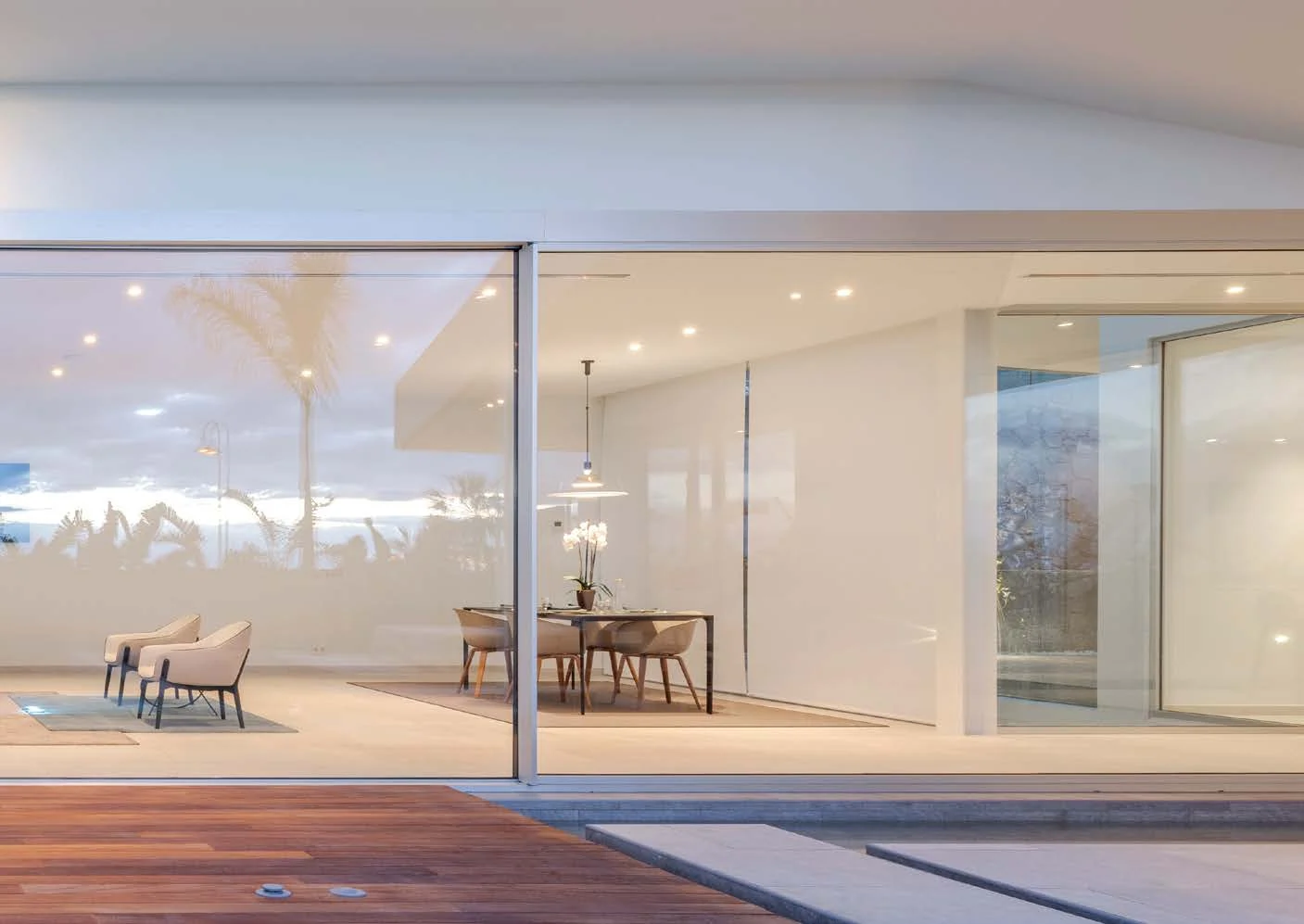
Furniture Placement
Arranging furniture around large sliding doors requires a balance between practicality and aesthetics. The key is to maintain clear pathways for the doors to operate while also creating inviting seating areas that take advantage of the views and light.
Consider positioning sofas and chairs to face the large sliding patio doors, allowing occupants to enjoy the outdoor vistas. L-shaped sectionals can work well, defining the living area while leaving space for door operation. Avoid placing large, heavy pieces directly in front of the doors, as these can impede movement and block light.
For dining areas adjacent to large sliding doors, consider a long rectangular table parallel to the doors. This arrangement allows diners to enjoy the view and provides easy access to outdoor spaces during meals or entertaining. In bedrooms with large sliding doors leading to balconies, position the bed to face the doors if possible, creating a luxurious wake-up experience with natural light and views.
Lighting
Large sliding doors flood interiors with natural light, which can impact your lighting design. During the day, these doors often provide ample illumination, reducing the need for artificial lighting. However, it’s important to plan for evenings and overcast days.
Layer your lighting approach to complement the natural light from large sliding doors. Use a combination of ambient, task, and accent lighting to create a flexible scheme. Wall-mounted sconces or track lighting can provide ambient light without competing with the doors for wall space.
Consider installing dimmer switches to adjust light levels as natural light changes throughout the day. For large internal sliding doors separating living spaces, ensure each area has its own lighting controls to maintain flexibility when the doors are closed.
Complementary Flooring
For external large sliding doors, consider using the same or similar flooring material inside and out. This could mean extending your interior tiles onto a patio or choosing decking that complements your indoor wooden floors. Ensure any materials used externally can withstand weather conditions and have appropriate slip resistance.
In areas with large internal sliding doors, consistent flooring throughout can make spaces feel larger when the doors are open. If different flooring is necessary, choose materials that complement each other in colour and texture to maintain a harmonious look.
Consider the practical aspects of your flooring choice as well. Large sliding doors can let in dirt and moisture, so opt for durable, easy-to-clean materials in high-traffic areas. For homes in cooler climates, underfloor heating can be a good option, helping to offset any heat loss through the expansive glass of large sliding doors.
Living with Large Sliding Doors
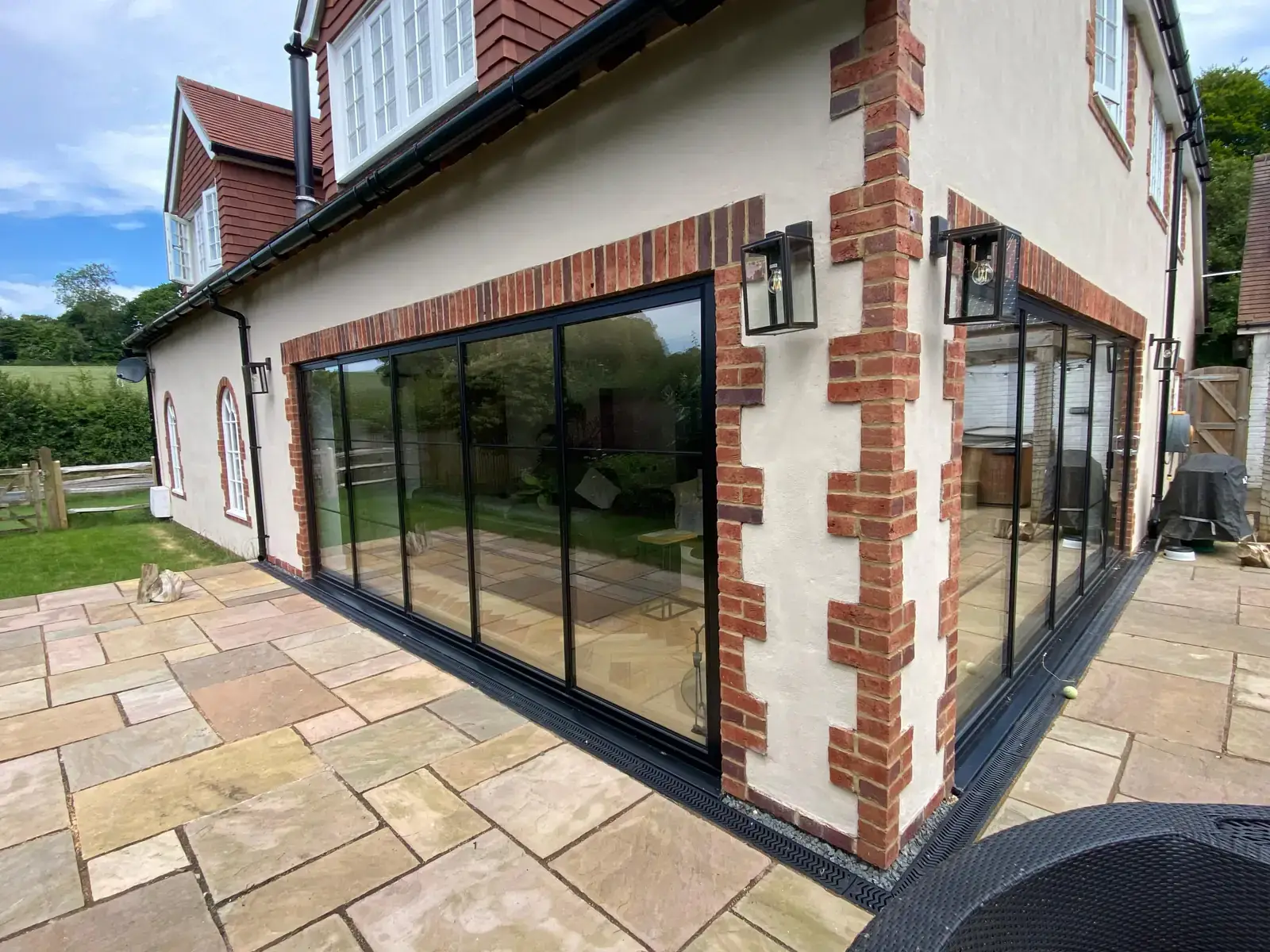
Maintenance and Cleaning
Keeping large sliding doors in top condition requires regular attention. The glass surfaces need frequent cleaning to maintain clear views. A solution of mild detergent and water, applied with a soft cloth or sponge, usually suffices for routine cleaning. For stubborn marks, a non-abrasive glass cleaner can be used.
Vacuum the tracks regularly and wipe them down with a damp cloth. Applying a silicone-based lubricant to the rollers and tracks every few months helps maintain smooth gliding action.
For large internal sliding doors, dust accumulation is often the primary concern. Regular dusting and occasional wiping with a slightly damp cloth should keep them looking their best. Pay attention to any handles or locking mechanisms, keeping them clean and lubricating moving parts as needed.
Security Measures
While large sliding doors offer beautiful views, they can also be a potential security weak point if not properly secured. Modern large sliding doors often come with multi-point locking systems that secure the door at several points along the frame when closed. These systems provide robust security, but it’s important to use them consistently.
Additional security measures can provide extra peace of mind. Consider installing security films on the glass to make it more resistant to breakage. For external doors, adding a security bar that fits into the bottom track can prevent the door from being forced open.
Energy Efficiency
Large sliding doors can impact your home’s energy efficiency due to their expansive glass areas. However, modern manufacturing techniques and materials have greatly improved their insulating properties. Double or triple glazing, low-emissivity coatings, and thermal breaks in frames all contribute to better energy performance.
To maximise the energy efficiency of large sliding patio doors, ensure they’re properly sealed when closed. Check weatherstripping regularly and replace it if it shows signs of wear. In summer, using external shading devices like awnings or pergolas can help reduce heat gain through the glass.
For homes in colder climates, consider using thermal curtains or blinds with your large sliding doors. These can be drawn at night to provide an extra layer of insulation. Some homeowners opt for motorised blinds that can be programmed to open and close at specific times, optimising natural light and heat management throughout the day.
Large Sliding Doors FAQ
How wide can large sliding patio doors be?
Large sliding patio doors can span impressive widths, often reaching up to 10 meters or more when multiple panels are used. The exact maximum width depends on factors such as the door system, frame material, and structural factors of the building. Some manufacturers offer custom solutions for even wider openings, potentially covering an entire wall.
What materials are best for large sliding door frames?
Aluminium doors are a popular choice for large sliding door frames due to their strength and slim profiles, allowing for ultra slim sliding doors with maximal glass area. Aluminium is also low-maintenance and can be powder-coated in various colours. Other materials like uPVC and timber are also used, each offering different benefits in terms of aesthetics, insulation, and durability.
Are large sliding doors energy efficient?
Large sliding doors can be energy efficient, with their thermal performance depending on factors such as glazing type, frame material, and installation quality. Modern large sliding doors often feature double or triple glazing, low-emissivity coatings, and thermal breaks in the frames to improve insulation. Proper sealing and weatherstripping also play major roles in maintaining energy efficiency.
What's the difference between sliding and bi-fold doors?
Sliding doors move horizontally along tracks, while large bifold doors fold accordion-style when opened. Sliding doors typically offer larger unobstructed glass areas when closed and take up less space when open. Bifold doors can open up almost the entire aperture but require more clearance space when folded back. The choice between the two often depends on the desired aesthetics, available space, and how the doors will be used.
Can large sliding doors be used as room dividers?
Large sliding doors can be excellent room dividers, offering flexibility in open-plan living spaces. They allow you to create separate areas when needed while maintaining an open feel when desired. Interior sliding doors used as room dividers can be made of various materials, including glass for light flow or solid panels for privacy.
Can large sliding doors be used in conservatories?
Sliding back doors are often used in conservatories, providing easy access to outdoor areas and allowing maximum light into the area. They work well in conservatories because they don’t require swing space, making them ideal for smaller areas. When choosing sliding doors for a conservatory, consider factors like thermal efficiency and UV protection to maintain a comfortable environment year-round.
How do I prevent birds from flying into my large sliding glass doors?
To prevent birds from colliding with large sliding glass doors, consider applying window decals, hanging external screens, or using patterned or frosted glass. Placing bird feeders closer to the doors can also help, as birds are less likely to fly into glass at slower speeds. Keeping internal blinds partially closed can reduce reflections that may confuse birds.
How do I choose the right sliding mechanism for large internal doors?
When selecting a sliding mechanism for large internal doors, consider factors such as the door’s weight, available wall space, and desired aesthetic. Types of sliding doors include surface-mounted systems, which are easier to install but visible, and pocket doors that slide into the wall for a cleaner look. For heavier doors, consider a robust track system with high-quality rollers to ensure smooth operation.
Are large sliding doors popular in living rooms?
Sliding glass living room doors, are increasingly popular in modern living rooms. They offer expansive views and flood the room with natural light. These doors can make living rooms feel more spacious and provide flexible access to patios or gardens.
What colours are popular currently for large sliding doors?
While colour preferences can vary, black sliding patio doors have gained significant popularity in recent years. Black frames offer a striking contrast against both interior and exterior elements, creating a modern, sophisticated look. Other popular colours include anthracite grey, which provides a similar contemporary feel, and white, which remains a classic choice.
We’d Love to Help You
Vision Glass Doors is a designer, manufacturer, and installer of premium door systems. We are a family run business with over 20 years’ experience and 5,000 installations across the UK.
Our leading range of door systems include Ultra Slim – Slide and Turn Doors, Slimline Sliding Patio Doors and Frameless Glass Doors. Suitable for various internal and external applications, they are applicable to residential and commercial projects.
Click Quick Quote Online for a free quotation within 24 hours. Alternatively, call or email us on 01582 492730 or at info@visionglassdoors.co.uk.

